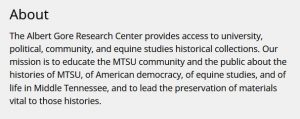This module forced me to rethink the what, who, how, and why of my own teaching. I have never read any of the authors/historians given for this module (other than a little Wineburg), and I appreciated the holistic approach each provided while simultaneously offering a slightly different view on how best to teach history or rather how best to teach students to study history as a living, fluid, complex discipline. From reading about and reflecting on “threshold concepts” to “decoding the discipline” to “uncoverage” it is more apparent to me than ever that teaching history has changed little over the past century. In my own research of educational trends during the Progressive Era: elective courses, practical majors (as opposed to purely philosophical or classical majors), extracurricular opportunities, and professors as experts are still core elements of teaching history and other mainstream subject areas. I have argued that a paradigmatic shift is long overdue and we are in the midst of just such a transition. Incidentally, it’s one reason that I joined the DH Certificate Program at GMU.
In teaching a course last fall in the Honors Program at Belmont University, we held an event featuring Dr. Joel Harrington, author of The Faithful Executioner (a book the class read) and department chair for the Vanderbilt’s History Department. Before he began he asked the fifty-five members of the Honors Program in attendance to introduce themselves and share their major. After they finished I had my own epiphany. There was not one history major, no English or Political Science majors, no foreign language majors, no economic majors, not even a single sociology or anthropology major. Instead the majors were all interdisciplinary, skills-based, or broadly categorized. Examples included: global leadership studies, nursing, publishing, music business, and sports science. I realized in this moment that I needed to reinvent my teaching and my discipline if I were to stay relevant (not to mention history as a subject). That includes both what I teach and how I teach. The readings and activities associated with this module only reinforce this conclusion, although there are three questions that will inform the way I actualize and implement my approach to teaching history today:
- How do I make history relevant to students?
I think the answer to this question starts with using current events, social media, and role play to generate empathy in an effort to “humanize history.” I made one attempt to do so using Twitter and allowing students to choose a figure of study from the Early Modern European period (the course’s title and scope). It worked great and culminated in a “Meeting of the Minds” in-class debate where the students channeled their historical figure to debate current issues. It was also a great deal of fun.
2. How do I make teaching history interdisciplinary?
I also strive to do this but have fallen short of a true course redesign. My greatest success is allowing students to complete a capstone project that takes the heart of our topic (in this class “Making the Modern City”) and apply it to Nashville. You can see from the student projects that their topics were wide-ranging and truly interdisciplinary. Their shared capstones were/are part of my own final project for HIST680 with Dr. Robertson.
http://drpethel.com/nashville/exhibits/show/past–present–future–downtow
3. Why do I teach history, and should the method matter?
The first part is easy. I love it. The most consistent feedback I get on evaluations, going back 15 years, is that I am passionate about what I teach. In watching Caldor’s interview I realize that I already employ aspects of “Uncoverage.” But I have much to learn to help students “decode the discipline” and get past “threshold concepts.” I also need to move more toward experiential learning and away from the text-driven/teacher-driven model. The method does matter, i.e. digital learning and projects help with the first two questions. But also important, my passion for the subject matters too. Because I love history I need to dissect and reexamine my methods as I continue to teach.
Postscript:
Dr. Kelly’s article “The History Curriculum in 2023” was music to my ears and I agree wholeheartedly with his view of teaching history and of the state of our history curriculum as it stands now. As an addendum to this post I believe his article has pushed me further toward a total course redesign for undergraduate and 9-12 history courses. At the high school where I teach they unveiled and made a substantial financial investment into a maker space that they named “Design Den.” And while it is open to all classes, it is not geared toward history or the humanities. We need history “lab” spaces and we need to better investigate ways to use 3-D printers and the like in our curriculum. As historians we cannot simply remain vessels of knowledge or even master teachers, we must also figure out how to harness new technologies to engage students actively and as participants while not abandoning basic skills of research, writing, and critical thinking. It is and will remain a challenge but one we must accept if we hope to stay relevant in a drastically changing landscape in higher education, and more important, skills that translate into the professional world.





